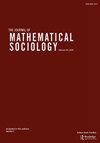执法:无犯罪社会的关键
IF 0.7
4区 社会学
Q3 MATHEMATICS, INTERDISCIPLINARY APPLICATIONS
引用次数: 1
摘要
本文旨在模拟一个简单的人造社会,它分为两个群体:罪犯和非罪犯。该系统的时间演化使用一组微分方程进行建模,借鉴了捕食者、流行病传播和收获模型的相关特征。每个群体可以在互动时切换类型。研究了该系统的稳定性和平衡点,得出的结论是,收获率和相互作用率在系统向种群之间不同稳定平衡的进化中发挥着重要作用,这些平衡最终融合为一个平衡。结果表明,只要收获率和转化率保持足够低,犯罪人口就会激增。然而,当两者中的任何一个超过一定值时,犯罪人口就会灭绝。本文章由计算机程序翻译,如有差异,请以英文原文为准。
Law Enforcement: The key to a Crime-free Society
ABSTRACT This paper intends to simulate a simple artificial society divided into two populations: criminal and non-criminal. The time evolution of the system is modeled using a set of differential equations, borrowing relevant features from the prey-predator, epidemic spread, and harvesting models. Each population can switch type upon interaction. The stability and equilibrium points of this system are examined, concluding that harvesting and interaction rates play an important role in the evolution of the system toward different stable equilibria between populations, which eventually coalesce into one. The results indicate that as long as the harvesting and conversion rates remain sufficiently small, the criminal population thrives. However, when either of the two crosses a certain value, the criminal population becomes extinct.
求助全文
通过发布文献求助,成功后即可免费获取论文全文。
去求助
来源期刊

Journal of Mathematical Sociology
数学-数学跨学科应用
CiteScore
2.90
自引率
10.00%
发文量
5
审稿时长
>12 weeks
期刊介绍:
The goal of the Journal of Mathematical Sociology is to publish models and mathematical techniques that would likely be useful to professional sociologists. The Journal also welcomes papers of mutual interest to social scientists and other social and behavioral scientists, as well as papers by non-social scientists that may encourage fruitful connections between sociology and other disciplines. Reviews of new or developing areas of mathematics and mathematical modeling that may have significant applications in sociology will also be considered.
The Journal of Mathematical Sociology is published in association with the International Network for Social Network Analysis, the Japanese Association for Mathematical Sociology, the Mathematical Sociology Section of the American Sociological Association, and the Methodology Section of the American Sociological Association.
 求助内容:
求助内容: 应助结果提醒方式:
应助结果提醒方式:


